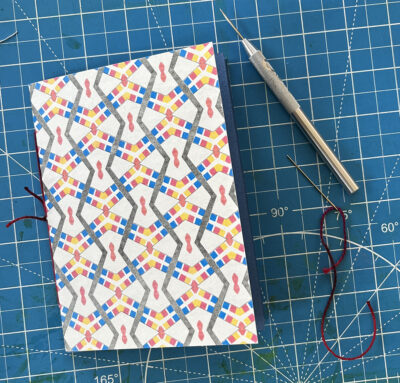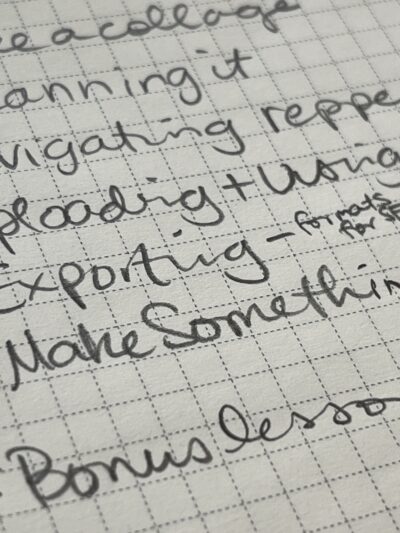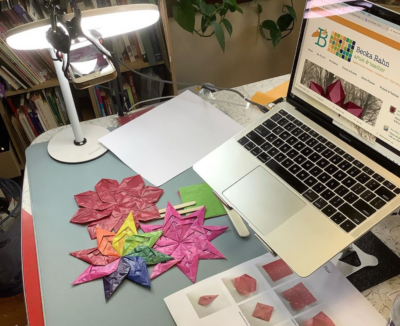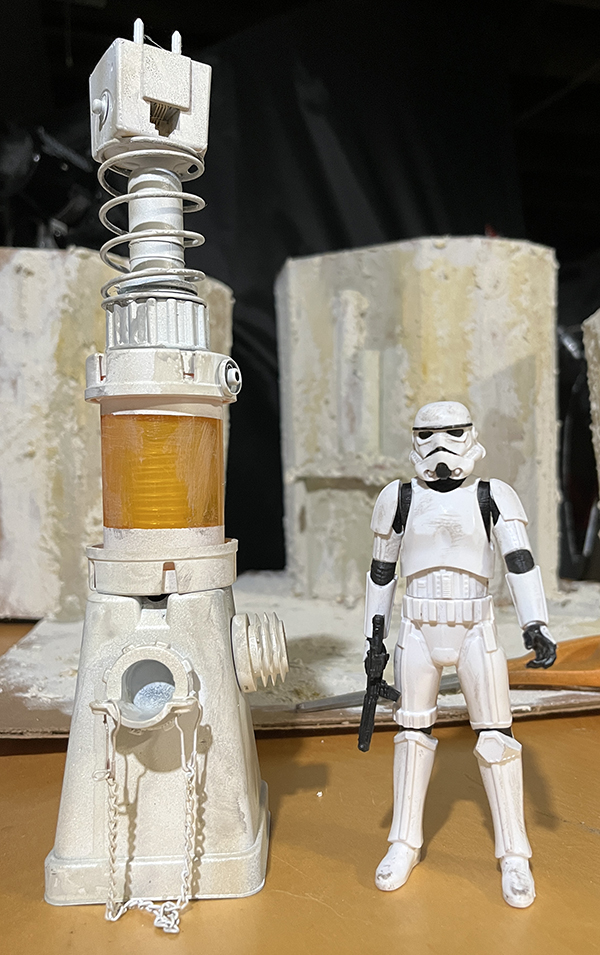A Day in the Life of an Artist: Thursday
Want to listen instead of reading?
Thursday.
Today was another round of tea, dog games and answering emails. This morning was a bit of a computer day. I spent a while taking the class outline I made yesterday and fluffing it out into lessons with bullet points. I’ve got it broken up now into the lessons and the main goals for each one and lots of notes for things I want to mention. I don’t ever script out my lessons, but I always work from bullet points. I’ve learned I don’t teach well from a script; it becomes too stilted and unnatural. (I tried using a teleprompter once and it was remarkably awful.) I’m probably ready to start filming some of the lessons next week.
Class prep
 This evening I am teaching an in-person class, which is unusual for me these days. The class starts at 5:30 which means I would be trying to get there in the absolute peak of rush hour, so I am actually planning to go several hours early and work from the library where the class will be held. I hate to be rushed and under pressure. And working from somewhere different is a nice change. I have a website to work on for a client, so that will be the perfect project to work on there since I don’t need anything from my studio to do that.
This evening I am teaching an in-person class, which is unusual for me these days. The class starts at 5:30 which means I would be trying to get there in the absolute peak of rush hour, so I am actually planning to go several hours early and work from the library where the class will be held. I hate to be rushed and under pressure. And working from somewhere different is a nice change. I have a website to work on for a client, so that will be the perfect project to work on there since I don’t need anything from my studio to do that.
I did a little class prep by rounding up some extra photos to have for examples. This is a class about photographing your small artwork and we’ll be doing hands-on examples and then I am going to demonstrate editing them. I taught this same class a few weeks ago and I felt like I needed a few more good examples to demonstrate with, so I went digging and got those ready. I double checked my slides and all of the materials I have to bring to this class. It’s kind of a complex class because I am setting up 3 white box variations so students can try shooting some of their own photos. So I have a lot of equipment to bring with me. I’ll do a check of my tech bag and make sure I have all of my adapters, cords, and various bits of technology. I’ve got to dig my computer power cable out from behind the studio bookcase because I don’t travel and teach as much any more and I only have one for this laptop. (I used to have two so I didn’t need to go digging for cords, but I haven’t gotten around to getting another one for this laptop.)
Lunch
Stanley came and told me it was time for lunch. His stomach is a very reliable clock. I also got my Amazon order (yay!) of an adapter for my computer to hook into the library’s LCD projector. At the last class, I didn’t have the right one and used my own projector instead. It’s been my experience that no venue ever has the adapter you need (so I always bring my own) and they all are set up assuming you have a PC, which I don’t. So I pack a bag full of my own equipment (cables, adapters, projector) every time because I know I can always make that work.
Proof of concept
After lunch, I made a quick “proof of concept” sample for the class I am working on. When I am putting together Skillshare classes, they put a big emphasis on the class project that students can make and share. For this class, I decided to do something that I hope will be a little fun. I am going to have a “simple” project which is to just create a digital file, but I am also going to have a “challenge” project lesson to take your surface design and actually make a thing with it. I get so tired of seeing mockups of everything that look so obviously computer generated. So I am going to challenge this class to make something with their design and I am going to walk them through making a simple stitched notebook with paper you might have just laying around. My sample is made from a sheet of cardstock printed with my new design, some kids construction paper, and a piece of perle cotton thread.
Sometimes I make several samples for this proof of concept step to make sure it’s something that’s teachable. I really like to encourage students to be creative and use what they have, so I am always trying to design interesting projects that don’t require you to go buy special tools or materials. I used my bookbinding awl for this sample, but I’ll also show how to do that step with a push-pin in class.
I’m also planning to make a couple more samples that are more complex pieces based on the same idea, showing how you can take the basic ideas and go farther with them. I ordered some printed wallpaper samples yesterday to make those pieces which I think will be a small coptic bound book and a covered pencil box.
Packing & hitting the road
Next I need to pack the car to get ready for class. This class has a lot of equipment to haul with me so I usually make a packing list. Since I taught this one already just a few weeks ago, when I put everything away, I put it all together in one place so it will be easy to grab and go. I’m also going to pack dinner, since class is at 5:30.
Class
I spent a few hours working in the very quiet library. I was starting the design for a new site for a printmaker and doing the fun part of setting up the colors, styles and little design elements before I start building the pages and menus. I ran into a big snag with her old website provider that had a super small limit on the image storage on her site so we decided to switch platforms altogether. I’ll probably work on that some more tomorrow so I can send her a rough draft to look at over the weekend. Then I grabbed my dinner as a picnic in the car, and headed in to teach class. It was a little bit of a mixed group with ages from about 10 to adults. It wasn’t supposed to be a kids class, so I am pretty sure the younger ones were pretty bored. (Sorry young friends!) It was really designed to be for people with Etsy shops or Ebay accounts looking to improve their photos. We got some pretty great photos with my very basic setups and I think several students walked away with some great ideas for their future photo shoots. I left everything in the car to unpack in the morning. I’m beat!



 Class planning.
Class planning.

 I got up and drank a very large cup of tea. Breakfast Assam is my favorite. Then I say “Good Morning” to Stanley, my yellow lab. This is a funny game he invented where he grabs a toy and marches round and round gurgle-growling his happy song while you say “Good Morning Stanley!” and scritch his ears. It’s part of his morning routine.
I got up and drank a very large cup of tea. Breakfast Assam is my favorite. Then I say “Good Morning” to Stanley, my yellow lab. This is a funny game he invented where he grabs a toy and marches round and round gurgle-growling his happy song while you say “Good Morning Stanley!” and scritch his ears. It’s part of his morning routine. I stitched up the samples for this class a couple of weeks ago while I was listening to another meeting. I love when I can get a couple of things done at once because making samples takes up a lot of my days. When I made class kits, I also make one for myself and so I have a basket I will pull out with my class kit and I’ll be all ready to go.
I stitched up the samples for this class a couple of weeks ago while I was listening to another meeting. I love when I can get a couple of things done at once because making samples takes up a lot of my days. When I made class kits, I also make one for myself and so I have a basket I will pull out with my class kit and I’ll be all ready to go. Class setup & lunch
Class setup & lunch While I was teaching I got two samples of Spoonflower’s new metallic wallpaper delivered; that was the UPS package. I seriously want to drop everything and make a couple of books covered with this new paper. It’s seriously gorgeous. I can’t wait to try it, but I have other things that have deadlines.
While I was teaching I got two samples of Spoonflower’s new metallic wallpaper delivered; that was the UPS package. I seriously want to drop everything and make a couple of books covered with this new paper. It’s seriously gorgeous. I can’t wait to try it, but I have other things that have deadlines.

 In August, after 3+ years of taking classes, I finished my Book Arts Certificate from the MN Center for Book Arts. It’s a program that they administer to “certify” artists in a study of book arts techniques. I think of it like a mini Masters Degree. I took classes which I loved (boxmaking, marbling) and ones that I did not love (letterpress).
In August, after 3+ years of taking classes, I finished my Book Arts Certificate from the MN Center for Book Arts. It’s a program that they administer to “certify” artists in a study of book arts techniques. I think of it like a mini Masters Degree. I took classes which I loved (boxmaking, marbling) and ones that I did not love (letterpress).









